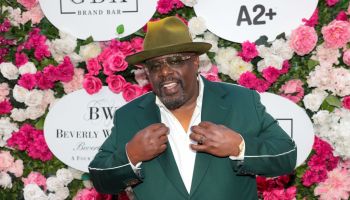It’s no secret. Police don’t often live by the same laws as the citizens they are tasked with protecting.
And often times, the ones designated to protect us can be the same ones that harm us. Police brutality isn’t a new development — in fact, paramilitary forces have been abusing their power for as long as there has been an authority in place. And more often than not, that brutality turns deadly. Problem is, the officers involved aren’t likely to bear the responsibility of a life lost or a person tortured.
From Rodney King to Jonathan Ferrell, here are some famous cases in recent history that showcase the prevalent and disheartening culture of police brutality…and the officers that walk free when all is said and done.
Jonathan Ferrell & Officer Randall Kerrick
In September 2013, former FAMU football player Jonathan Ferrell crashed his vehicle in a suburban area of Charlotte, North Carolina and went seeking help. After knocking on the door of a nearby house, the homeowner panicked and called the police. Charlotte-Mecklenberg officers said the 24-year-old advanced towards them when they arrived on the scene — that’s when one officer fired a stun gun and Officer Randall Kerrick followed up, unloaded his firearm and shot the unarmed young man 10 times. Ferrell was pronounced dead and Kerrick charged with voluntary manslaughter. In January 2014, a grand jury decided not to indict Kerrick, citing insufficient evidence to bring a case against the officer. [UPDATE Jan. 27: A second grand jury has indicted Officer Kerrick].
Israel Hernandez-Llach & Officer Jorge Mercado
Miami police used a Taser to subdue 18-year-old graffiti artist Israel Hernandez-Llach in August. Officers caught the teen tagging a building. After chasing him, officer Jorge Mercado employed the use of the stun gun on Llach, killing him with excessive force. Friends of Llach say the officers involved high-fived each other and joked about the teen’s death: “You should have seen how funny it was when his butt clenched when he got Tased.” Mercado, a 13-year veteran on the force, was put on administrative leave.
Timothy Stansbury Jr. and Officer Richard S. Neri Jr.
In 2004, Officer Neri shot and killed Stansbury — an unarmed 19-year-old with no criminal record. Neri claimed Stansbury startled him and he fired by mistake. He was suspended for 30 days. Later, a grand jury declined to indict Neri on charges of criminally negligent homicide and manslaughter, finding the shooting to be accidental.
Amadou Diallo & The Four Officers
In one of the most excessive cases of police brutality and protection of officers, a West African immigrant was shot at 41 times after four NYPD officers in plainclothes approached him on the way into his NYC home. Police say the 23-year-old had a gun, but it was later found to be a wallet. All officers were acquitted of second-degree murder charges in the 1999 incident.
Oscar Grant III & Officer Johannes Sebastian Mehserle
In the early morning hours of New Year’s Day 2009, Grant and several other passengers were detained on the platform at the Fruitvale BART Station after officers responded to a fight. Mehserle and another officer restrained Grant after he tried to explain what happened. He was placed face down when Mehserle, who claimed Grant was trying to resist arrest, shot him in his back. He later told authorities he thought he was pulling out his stun gun. The incident, which spurred an award-winning movie in 2013, was caught on video by dozens of passengers’ cell phone cameras. Grant was unarmed and pronounced dead the next day. Mehserle was found guilty of involuntary manslaughter and spent less than a year of his two-year sentence behind bars.
Rodney King
Arguably the most infamous case of police brutality happened in March of 1991, when five LAPD officers surrounded Rodney King, an African-American construction worker, after an alleged high speed car chase. The brutal video, taken by a witness who taped it from his balcony, shows the officers striking and beating Rodney badly. He was also Tasered twice and in the end, suffered a fractured facial bone, a broken right ankle, and multiple bruises and lacerations, 11 skull fractures, permanent brain damage, broken bones and teeth, as well as kidney damage. Four of the officers were charged with assault with a deadly weapon, but three acquitted of the charges. The jury acquitted the fourth of assault with a deadly weapon, but failed to reach a verdict on the use of excessive force. In 1993, the officers were retried by a federal grand jury and two were found guilty and imprisoned. The other two, however, were acquitted again.
Kenneth Chamberlain Sr.
Police in White Plains, New York shot and killed Kenneth Chamberlain Sr. in November 2011, after he inadvertently triggered his Life Aid medical alert necklace. When police arrived at his home, he informed them of the accident and declined to open the door. Frustrated, the officers taunted Chamberlain, calling him racial epithets and sending death threats. His niece, who lived in the same apartment building, later told the NYT that she could hear her uncle saying that the officers were going to kill him. They broke down the 68-year-old veteran’s door, Tasered him and shot him twice. Police tried to say he charged at them with a knife. A grand jury reviewed the case and decided that no criminal charge would be made against police officers involved in the killing, however, the officer who shot has since been fired.
Kendrec McDade
Kendrec McDade, 19, was shot and killed by police in March of 2012, when officers responded to a report of an armed robbery in Pasadena, CA. Later, police discovered the teen was unarmed, and in fact only carrying a cell phone. His family filed a lawsuit arguing that Kendrec did not receive emergency care immediately after being shot, but the officers involved were only suspended and placed on administrative leave for a short period of time. They have since returned to work.
Lt. John Pike
The former University of California, Davis police officer John Pike was initially terminated after the image of him pepper-spraying Occupy protestors went viral in November 2011. But in October of 2013, Pike reached a worker’s compensation settlement with the university system, receiving $38,000 and claiming he suffered depression and anxiety after receiving death threats. In other words, Pike won in the end.
Marlon Brown & Officer James Harris
Marlon Brown of Florida was struck and killed by a police cruiser in May of 2013 after being pursued by police for a seatbelt violation. Brown hopped out the car and started escaping on foot. That’s when Officer James Harris, who was behind the wheel, accelerated towards the fence Brown was headed for. He struck Brown with the cruiser, killing him, but in September of 2013, a grand jury decided not to charge Harris with any crimes. Watch the graphic video above.
Keith Vidal & Officer Byron Vassey
Mark Wilsey and his wife, Mary, are still searching for answers after their son, 18-year-old Keith Vidal, was shot to death by police in January 2014. The couple called North Carolina police to the scene to help their son get over a schizophrenic episode. But when they arrived, an officer exclaimed that he didn’t have time for this and proclaimed: “Taser him.” After the officer used the stun gun, another shot him. Days later, the two cops involved in the shooting were cleared by an internal investigation.
Ousmane Zongo & Officer Bryan A. Conroy
Zongo was killed in 2003 by Officer Conroy in NYC during a raid on a counterfeit-CD ring. Conroy confronted Zongo, who had nothing to do with the ring. Conroy was convicted for criminally negligent homicide, but did not serve jail time. A judge later said he was “insufficiently trained, insufficiently supervised and insufficiently led.”
Robert Cameron Redus & Officer Chris Carter
In December 2013, Texas college student Robert Cameron Redus was shot and killed by campus police during a traffic stop. The officer, Chris Carter, told authorities Redus resisted arrest and hit him with his own nightstick. That’s when Carter opened fire, shooting the University of the Incarnate Word student, who was co-valedictorian of his high school, six times. His family believes differently. A witness at the scene says he heard Redus ask the officer if he was going to shoot him. Carter did just that. As of January 2014, Carter was still on paid leave, but no charges were brought against him.
Andy Lopez & Officer Erick Gelhaus
In October, Officer Gelhaus shot and killed a 13-year-old California boy, Andy Lopez, after he spotted the teen with a toy rifle resembling an AR-15. Witnesses say it took less than 10 seconds for Gelhaus, who fired more than seven times, to open fire on the teen. No charges were brought against Gelhaus. As of December 2013, the shooting is being investigated.
Sean Bell
The night before his wedding day in 2006, police fired more than 50 bullets into the car carrying Bell and his three friends outside a Queens, N.Y. strip club. A plain-clothes officer, who said he believed that Bell and his friends had a gun, told authorities he called for backup after alerting the men he was a detective. When they drove off, the detectives fired the shots into the car, killing an unarmed Bell and wounding two of the friends. The detectives went on trial for charges ranging from manslaughter to reckless endangerment, but were later found not guilty.
Patrick Dorismond
In 2000, Dorismond, the 26-year-old father of two young girls, was shot during a confrontation with an undercover police officer in New York City. The police officer approached Dorismond outside of a lounge to ask where he could purchase drugs. During a scuffle, which was said to start after Dorismond declared he was not a drug dealer, the officer shot him. Later, he would claim it was Dorismond who caused his own death by grabbing the officer’s gun. The question still remains why the gun was pulled out in the first place. In July 2000, a grand jury decided not to indict the officer in Dorismond’s death.
Aiyana Jones
Seven-year-old Aiyana Jones was shot and killed on May 16, 2010 by a Detroit police officer during a raid conducted by the department’s Special Response Team. Her death was tragically caught on tape — the raid was being recorded for the hit A&E show The First 48. Aiyana was asleep on the couch when police raided the home. Detroit police were looking for a murder suspect, but came upon the 7-year-old first and shot her within seconds of entering. In October of 2011, a grand jury indicted Officer Joseph Weekley on involuntary manslaughter and reckless endangerment. His trial, which took place in June, ended in a deadlocked jury. It has been rescheduled.
Ervin Jefferson
The 18-year-old Atlanta teen was shot and killed in March 2012 by two security guards responding to an altercation outside of the boy’s home. Ervin was attempting to protect his sister when he ran outside their home on Pleasantwood Drive toward a crowd of people who had driven up in at least two cars. Instead, he was shot dead. The security guards in question were not arrested.
Robert Saylor
In January 2013, Robert Saylor died while being held in police custody after being detained at a movie theater. The 26-year-old bought a ticket for a screening of Zero Dark Thirty at a theater in New Market, Md., but allegedly stayed after. When he refused to leave, cops put him face down on the ground. Later, it was found that he had died of asphyxiation. No officers were charged in his death.
Steven Eugene Washington
The 27-year-old autistic man was shot by gang-enforcement officers Allan Corrales and George Diego in 2010. Officers in Los Angeles claimed that Washington approached them and proceeded to remove something from his waistband. No weapon was ever recovered, and the officers involved avoided charges.
Alonzo Ashley
Ashley, a 29-year-old who was visiting the Denver Zoo in 2011, was killed with a Taser by police, who claimed the man had “extraordinary strength.” Ashley allegedly refused to stop splashing water from a drinking fountain on his face that day, then made irrational comments and threw a trash can, causing police to react. No criminal charges were filed against them.
Kimani Gray
In March 2013, undercover cops claiming that 16-year-old Kimani Gray was armed shot him four times in the front and side of his body and another three times in the back. The undercover cops who shot Kimani in Brooklyn, N.Y. said they approached him and he “adjusted his waistband” in what the police described as a suspicious manner. When the police asked him to “show his hands,” they claim Kimani turned around and pointed a gun at the officers, who then fired 11 rounds. Gray didn’t fire any shots with the weapon police claimed he had. The only eyewitness to the shooting contends that the teen was empty-handed. The officers have yet to be charged.
Ramarley Graham
Police in the Bronx, N.Y. shot and killed 18-year-old Ramarley Graham in 2012 while he was in the bathroom of his grandmother’s home, allegedly flushing marijuana down the toilet. Officer Richard Haste chased the unarmed teen into the home, although he did not have a warrant. A grand jury charged Haste with manslaughter. Later, a judge tossed the indictment, ruling that the prosecution inadvertently misled jurors by telling them not to consider whether he was warned that Graham had a gun.
Timothy Russell
Russell was killed in Cleveland with his passenger when officers fired 137 rounds into their car after a chase in December 2012. Police say they saw a weapon in the car, but a search of the vehicle revealed that no weapon or shell casings were found. No officers were reprimanded.
Victor Steen
Seventeen-year-old Florida teen Victor Steen was killed after a police officer used a Taser to subdue him and then ran him over with his police cruiser. Steen had refused to stop riding his bicycle during the chase. The incident was caught on video, which you can see above. The officer was not charged in Victor’s death.
Darrin Manning
Darrin Manning, a straight-A student at Mathematics, Civics & Sciences Charter School in Philadelphia, underwent surgery after a female police officer ruptured his testicle during a pat-down in January 2014. Manning was with a group of teammates on their way to an after-school basketball game when he was stopped by the officer. During the search, she pulled down and he heard a pop. Doctors say the rupture may have caused fertility issues. The officer was not charged, but an internal investigation is underway.
PHOTO CREDIT: Getty, Family Handout, Screengrab, Facebook

















